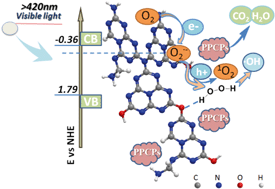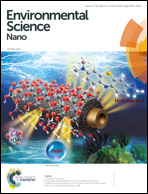A photocatalytic degradation strategy of PPCPs by a heptazine-based CN organic polymer (OCN) under visible light†
Abstract
Polymeric photocatalysts have desirable application prospects due to their low cost and controllable structures. Here, we report on the synthesis of a highly effective and stable oxygen- and nitrogen-linked heptazine-based carbon nitride organic polymer (OCN) photocatalyst that is metal-free and porous, with low crystallinity and nitrogen vacancies, which is prepared through a single-step approach. For the photocatalytic degradation of several typical PPCPs, the OCN exhibited excellent photocatalytic performance compared to C3N4. The enhanced mechanisms were investigated novelty, and the conduction band, crystallinity and recombination rate of photogenerated carriers were reduced due to the introduction of oxygen atoms and nitrogen vacancies, whereas the fabrication of porous structures provided additional adsorption sites. The mechanism of hydroxyl radical generation in the OCN system was first proposed under this system. The O linkages can form hydrogen bonds with H2O2 to promote the catalytic generation of hydroxyl radicals (˙OH). The presence of ˙OH, O2˙− and 1O2 (detected by ESR) indicated that the OCN polymer could be employed to degrade organic pollutants.



 Please wait while we load your content...
Please wait while we load your content...